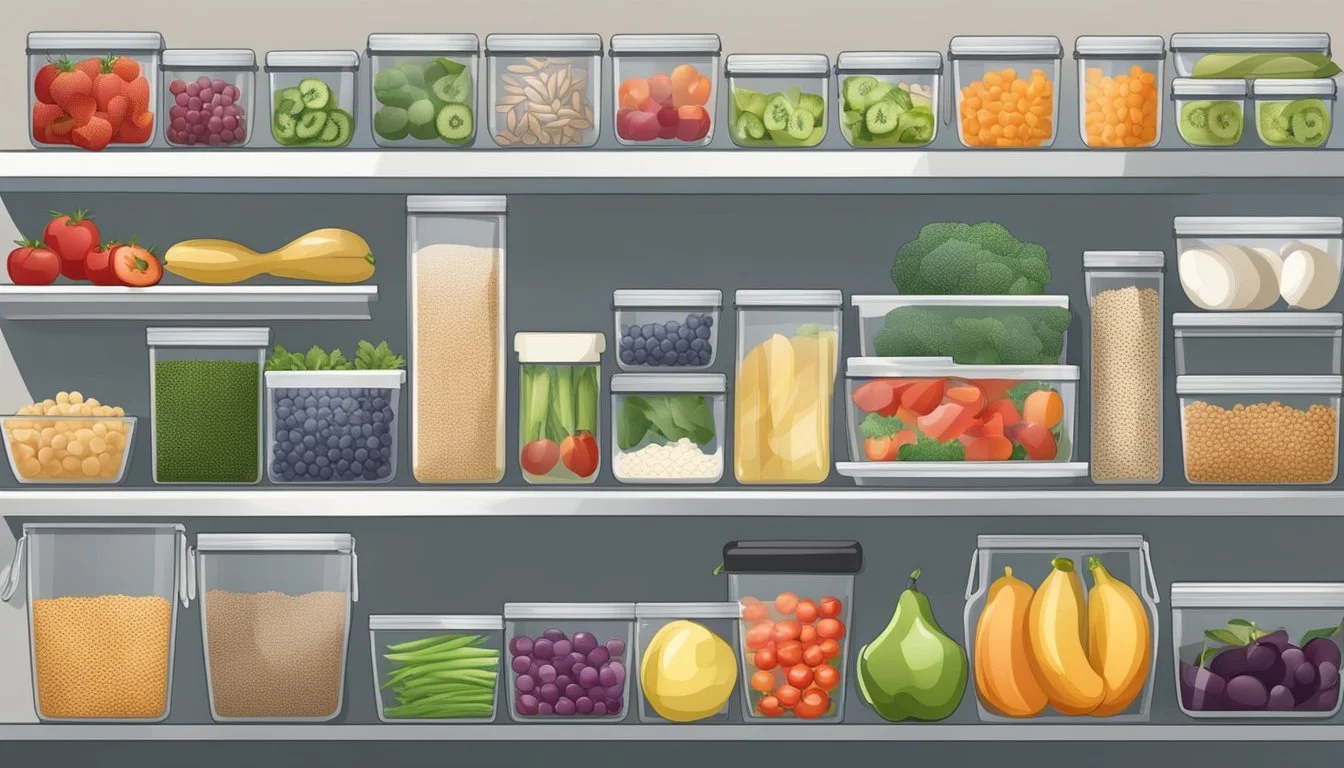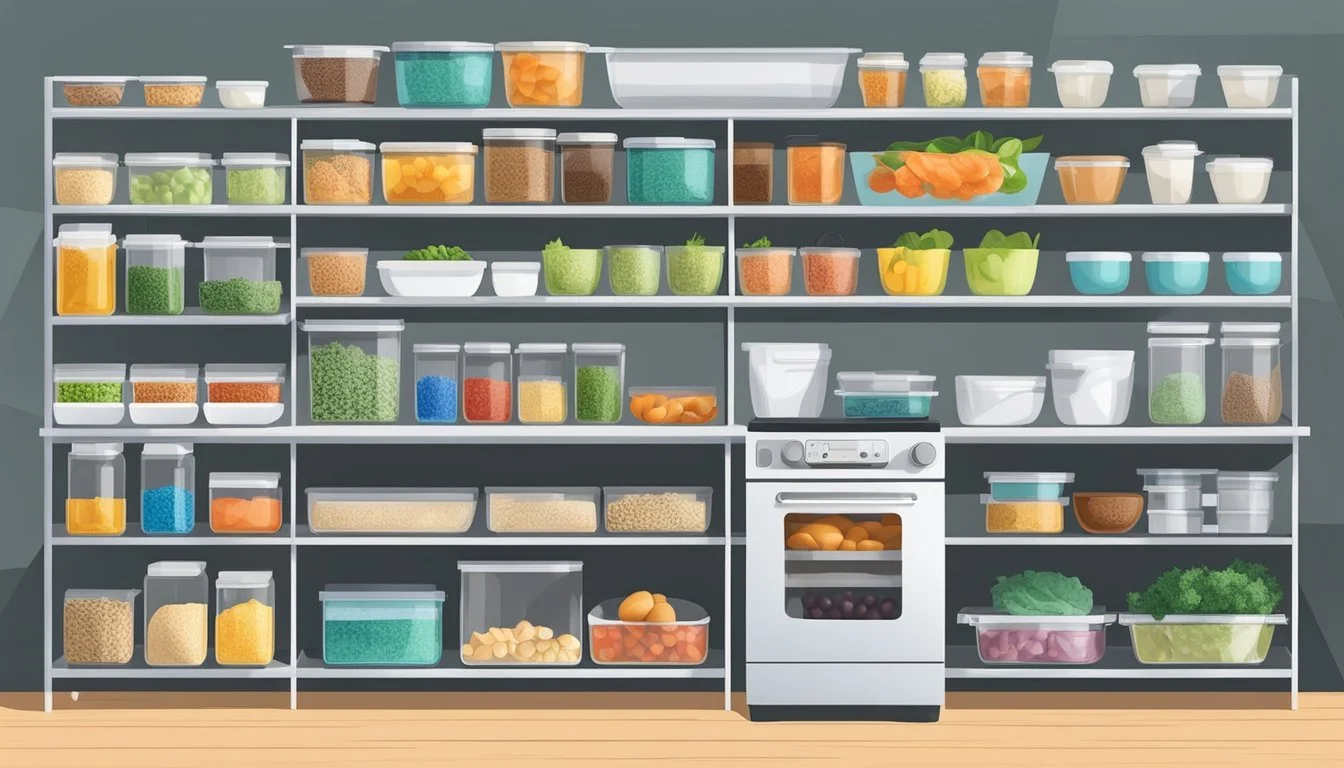The Ultimate Guide to Organizing Your Kitchen for a Low-Histamine Diet
Streamline Your Space for Healthier Living
Individuals diagnosed with histamine intolerance require a strategic approach to meal preparation and kitchen organization. Histamine intolerance occurs when the body cannot break down histamine efficiently, leading to symptoms such as headaches, hives, or digestive issues. To manage these symptoms, it's imperative to follow a low histamine diet, which involves selecting foods that are less likely to trigger adverse reactions and organizing the kitchen to minimize exposure to high-histamine items.
A low histamine diet centers around fresh, minimally processed foods while avoiding those known to be high in histamine or histamine-releasing ingredients. This includes making informed choices on meats, fish, dairy substitutes, and grains that do not contribute to increased histamine levels in the body. Olive oil, coconut oil, fresh meats, certain freshly caught seafood, cooked eggs, and specific grains like rice are typically recommended for this diet.
Organizing the kitchen for a low histamine diet means ensuring meals are planned and ingredients are stored in a way that discourages histamine buildup. This involves promptly refrigerating perishable items, utilizing proper storage methods, and selecting kitchen tools that help with quick and efficient meal preparation. It also includes maintaining a rotation of fresh produce and keeping a well-organized pantry with clearly labeled low-histamine food options to streamline the cooking process.
Understanding Histamine and Your Body
Understanding the role of histamine in the body and recognizing signs of histamine intolerance are crucial first steps for organizing a kitchen around a low-histamine diet.
What Is Histamine?
Histamine is a chemical involved in the immune system, regulating physiological function in the gut and acting as a neurotransmitter. It plays a key role in the body's response to foreign pathogens. However, histamine can cause issues when it accumulates in excess.
Symptoms and Signs of Histamine Intolerance
Histamine intolerance occurs when there's an imbalance between accumulated histamine and the capacity to break it down. Symptoms vary, but often include:
Skin reactions: such as hives and swelling.
Gastrointestinal complaints: including abdominal pain and bloating.
Respiratory problems: such as nasal congestion and asthma.
Neurological symptoms: including headaches and fatigue.
Role of Diamine Oxidase (DAO) Enzyme
The DAO enzyme is critical for breaking down dietary histamine. Low levels of this enzyme can lead to histamine intolerance, as histamine from food isn't adequately processed. DAO supplements may help alleviate symptoms by supporting the breakdown of histamine in the digestive system.
Components of a Low-Histamine Diet
Embarking on a low-histamine diet involves understanding which foods to select, which to avoid, and how certain foods can naturally help manage histamine levels. Careful organization and knowledge of these components can help individuals adhere to this dietary approach more effectively.
Identifying Low-Histamine Foods
A low-histamine diet is centered around foods that have a minimal histamine content. Key to this diet are:
Freshly cooked meats and poultry: They are preferable to leftovers, which may accumulate histamine due to microbial action.
Fresh-caught fish: Ideally eaten right after cooking to prevent histamine formation.
Non-citrus fruits: Such as apples, pears, and melons.
Vegetables: Most are well-tolerated, but it is important to avoid spinach, tomatoes, and eggplant.
Grains: Like rice, quinoa, and buckwheat.
Cooking oils: Olive oil and coconut oil are suitable choices.
Dairy substitutes: These include almond milk and hemp milk.
Always choose fresh, unprocessed ingredients as the foundation of a low-histamine diet.
High Histamine Foods to Avoid
On a low-histamine diet, certain foods should be avoided due to their high histamine levels or ability to trigger histamine release:
Aged cheeses (What wine goes well with aged cheeses?): They are known to have higher levels of histamine.
Alcoholic beverages: Such as wine and beer, which can both contain histamines and provoke histamine release.
Fermented foods: Including sauerkraut, yogurt, kefir, and soy products.
Processed meats: Such as salami, pepperoni, and smoked fish.
Leftover or stored foods: As histamine levels can increase with time.
When compiling a grocery list or arranging your kitchen, it's essential to steer clear of these items.
Natural Antihistamine Foods
In addition to low-histamine foods, incorporating natural antihistamine foods can help manage histamine levels. Some examples include:
Flavonoid-rich foods: Apples, onions, and berries contain quercetin, a natural antihistamine.
Vitamin C rich foods: Such as kiwifruit and bell peppers, which can help lower histamine levels.
Omega-3 rich foods: Found in fish like salmon and mackerel, they may have anti-inflammatory effects that can help mitigate histamine-related responses.
Include these foods in your diet to help balance histamine levels naturally.
Dietary Strategies for Histamine Management
In managing histamine levels through diet, individuals should focus on the consumption of fresh foods, the strategic planning of meals, and the diligent tracking of food intake.
The Importance of Freshness
For those following a low-histamine diet, the freshness of food is paramount. Proteins such as fish or chicken should be consumed soon after purchase to ensure low histamine levels. Avoiding aged, smoked, or processed protein sources is crucial as these have higher histamine content.
Freshness Tips:
Protein: Purchase and consume within 24 hours.
Vegetables: Opt for fresh over canned or leftover.
Meal Planning and Preparation
Strategic meal planning and preparation can simplify adhering to a low-histamine diet. Individuals are encouraged to prepare their meals from scratch, using fresh ingredients and simple cooking methods that do not contribute to histamine formation.
Meal Plan Ideas:
Breakfast: Fresh scrambled eggs with spinach.
Lunch: Grilled chicken salad with a selection of low-histamine vegetables.
Dinner: Pan-seared trout with a side of steamed broccoli and quinoa.
Maintaining a Food Diary
Keeping a food diary is an effective way to identify foods that may trigger symptoms. Recording everything consumed, along with any reactions, can aid in making informed dietary changes. This tracking should include specific details about the ingredients, cooking methods, and the freshness of the consumed food.
Food Diary Entries:
Date and Time: Log when the food was consumed.
Food Details: Note the specific ingredients and cooking methods.
Symptoms: Document any adverse reactions post-consumption.
Organizing Your Kitchen
When embarking on a low-histamine diet, proper organization of the kitchen becomes a crucial step in maintaining dietary restrictions. Ensuring that the kitchen is set up with safe food storage solutions and equipped with the right cooking appliances can streamline the process of preparing low-histamine meals.
Safe Food Storage Solutions
One's kitchen should incorporate designated areas that reduce the risks of histamine build-up in foods. This includes:
Refrigeration: Histamine levels increase with time, so rapid refrigeration of perishable items is imperative.
Adjustable Temperature Control: Keep your refrigerator between 32°F and 41°F to slow down histamine formation.
Designated Sections: Allocate separate areas for histamine-safe foods to prevent cross-contamination.
Freezer Organization:
First In, First Out (FIFO): Label and date all items placed in the freezer to ensure older items are used before newer ones, minimizing the chance of histamine development due to extended storage.
Vacuum Sealing: This method is ideal for preserving the freshness of leftovers and reducing exposure to air, which can lead to increased histamine levels.
Choosing the Right Cooking Appliances
For a low-histamine diet, the choice of cooking appliances is pivotal as they influence food preparation and storage of leftovers. Consider:
Pressure Cookers: They are excellent for rapidly cooking meals, which is crucial to minimize histamine production.
Air-Tight Food Containers: When storing leftovers, always opt for air-tight containers, which help maintain food quality and limit histamine spikes.
Appropriate kitchen organization and careful selection of appliances provide the foundation for managing a low-histamine diet. This kind of environment supports the individual's health by mitigating potential dietary risks.
Selecting and Handling Ingredients
When embarking on a low-histamine diet, the freshness and quality of the ingredients play a critical role. The handling and storage of vegetables, fruits, meats, and fish are essential to minimize histamine levels.
Proper Selection of Vegetables and Fruits
Selecting the right vegetables and fruits is paramount for maintaining a low-histamine diet. Individuals should opt for fresh produce over canned or preserved options, as histamine levels can increase over time. It is advisable to buy organic produce to avoid histamine triggers commonly found in pesticides. Some vegetables and fruits are naturally higher in histamines; therefore, it's important to research and avoid those that can aggravate symptoms.
Recommended Vegetables: Zucchini, cucumbers, and leafy greens
Recommended Fruits: Apples, pears, and mangoes
Storage Tip: Refrigerate produce promptly to slow down histamine production.
Choosing Fresh Meats and Fish
For meat and fish, the emphasis should be on absolute freshness. Meat should be purchased from a trusted source, ensuring it is freshly cut and has undergone minimal processing. Poultry is generally a better choice for a low-histamine diet due to lower histamine levels compared to aged meats.
Fish should be bought fresh and cooked the same day to avoid histamine development. Avoid smoked or preserved fish, as these preparation methods can lead to high histamine contents.
Preferred Meats: Fresh cuts of beef, skinless chicken breasts
Preferred Fish: Flounder, trout, and cod
Handling Guidance: Prepare and cook meats and fish immediately after purchase when possible, and freeze immediately if not to be consumed right away.
Cooking Low-Histamine Dishes
To maintain a low-histamine diet, careful selection of cooking methods and meal components is crucial. One must navigate recipe choices and ingredient substitutions to ensure that meals support dietary needs without compromising on taste or nutrition.
Recipes for Low-Histamine Diets
For individuals who follow a low-histamine diet, they need recipes that emphasize cooking methods which prevent the accumulation of histamine. They should consider using techniques like sautéing, braising, steaming, and baking at low to medium temperatures. These methods mitigate histamine formation compared to slow cooking or smoking. The use of a pressure cooker can be particularly effective for cooking dishes quickly, minimizing the time food has to develop histamine. Additionally, it is recommended to use glass containers over plastic for storage to avoid chemicals that might trigger histamine release.
Sauteed Vegetables: Cook green beans, carrots, or bell peppers with a small amount of olive oil over medium heat.
Braised Chicken: Use cuts of chicken that are less likely to accumulate histamine, cook with broth and permissible herbs until tender.
Steamed Fish: Opt for fresh, never-frozen fish fillets, and steam with allowed seasonings for a quick, delicious entrée.
Creating Balanced Sides and Snacks
When preparing sides and snacks on a low-histamine diet, they should favor items that are not only easy to prepare but also low in histamine. Grains like millet serve as excellent bases, seasoned with herbs that do not trigger histamine release. For snacks, consideration of food composition and freshness is key to avoid histamine buildup— freshly made popcorn without added cheese or butter is a simple, satisfying choice.
Herbed Millet: Cook millet until fluffy, then mix with fresh herbs such as chives or parsley.
Fresh Vegetable Sticks: Slice cucumbers, carrots, and celery to eat raw or dip into a homemade low-histamine hummus.
By focusing on these recipes and food preparation suggestions, individuals can create a kitchen environment conducive to a low-histamine diet. These meals can help manage symptoms associated with histamine intolerance and provide a varied and enjoyable culinary experience.
Adapting to Dietary Restrictions
When organizing a kitchen to cater to a low-histamine diet, understanding how to adapt to dietary restrictions is crucial. Effective management involves a methodical approach to elimination diets and continuous coordination with healthcare professionals.
Implementing an Elimination Diet
An elimination diet is instrumental in identifying foods that trigger histamine responses. Such a diet involves removing certain foods or ingredients that are known or suspected to elevate histamine levels. The individual should begin by strictly avoiding these items for a period of time, typically four to six weeks. During this phase, keeping the kitchen stocked with low-histamine foods and preparing meals that conform to this requirement is essential. It's beneficial to create separate storage sections for safe and restricted foods to prevent cross-contamination.
Initial Steps: Remove high-histamine foods, such as aged cheeses, smoked meats, and certain vegetables.
Food Storage: Clearly label and store low-histamine foods in separate containers.
Meal Prep: Design meal plans that incorporate fresh meat, certain fresh fruits, and cooking methods that minimize histamine production.
Interaction with Healthcare Professionals
Regular interaction with healthcare professionals is key to customizing a diet that ensures symptom relief and nutritional adequacy. A registered dietitian familiar with low-histamine diets can provide invaluable guidance on meal planning and kitchen organization. It is advisable to meticulously document dietary changes and symptom patterns, which can then be reviewed by the healthcare provider to tailor dietary interventions more effectively.
Consultation: Schedule regular appointments with a registered dietitian for personalized diet planning.
Documentation: Keep a food and symptom diary to discuss with healthcare professionals.
Adjustments: Based on the dietitian's feedback, make necessary adjustments to the kitchen setup and diet plan.
Maintaining a low-histamine diet involves a careful balance of preparation, knowledge, and support. Adapting the kitchen to suit these dietary changes can lead to improved management of symptoms and overall well-being.
Dealing with Symptoms and Flare-ups
Navigating a low-histamine diet requires an understanding of how to manage and mitigate symptoms related to histamine intolerance. Recognizing signs of a flare-up and understanding contributing factors are crucial to maintaining symptom control.
Recognizing and Recording Symptoms
One should maintain a symptom journal to track the onset of symptoms, which may include headaches, fatigue, itching, bloating, and gastrointestinal symptoms. Recording these symptoms diligently can help identify patterns and triggers. Here is a basic structure for a symptom journal:
Date/Time: Record when the symptom occurred.
Symptoms: Note specific symptoms experienced.
Duration: Indicate how long the symptom lasted.
Severity: Rate the severity on a scale (e.g., 1-10).
Diet/Environment: List foods consumed or environmental factors present.
Non-Dietary Factors Influencing Histamine Levels
Non-dietary factors play a critical role in histamine levels and the severity of reactions. Stress can exacerbate histamine-related symptoms and lead to increased inflammation and anxiety, while symptom relief may be found through stress-reduction techniques. Methods to manage stress include:
Mindfulness Meditation: Can help reduce stress and anxiety levels.
Regular Exercise: Aids in stress management and can improve histamine tolerance.
Adequate Sleep: Ensures the body can recover and can mitigate the impact of stress on symptoms.
By employing strategies for both recognizing and recording symptoms, as well as addressing non-dietary factors, individuals can take proactive steps to control flare-ups attributable to histamine intolerance.
Conclusion
Adopting a low histamine diet has significant potential for those grappling with histamine intolerance to improve their quality of life. By carefully selecting foods low in histamine and preparing meals that minimize histamine content, individuals can effectively manage sensitivity and reduce intolerance symptoms. Here are key strategies to remember:
Freshness is Key: Favor fresh, minimally processed foods, as histamine levels rise in aged or processed items.
Knowledge is Power: Awareness of high-histamine foods to avoid is crucial in making dietary choices that support well-being.
High-Histamine Foods to Avoid Recommended Low-Histamine Alternatives Aged cheeses Freshly cooked meats and poultry Alcohol Cooked eggs (mainly yolk) Processed meats Grains like rice and quinoa
Individual Response Matters: Each person's reaction to histamine is unique, necessitating attentive tracking of food intake and symptoms.
Resourcefulness is Beneficial: Utilizing resources such as low-histamine recipes and guides can aid in effective meal planning and symptom management.
By embracing these practices, individuals with histamine sensitivity can aspire not only to alleviate symptoms but also to take pleasure in diverse and nourishing meals. The ultimate goal of managing a low histamine diet is not merely to restrict, but to empower individuals to thrive with knowledge and intention.








